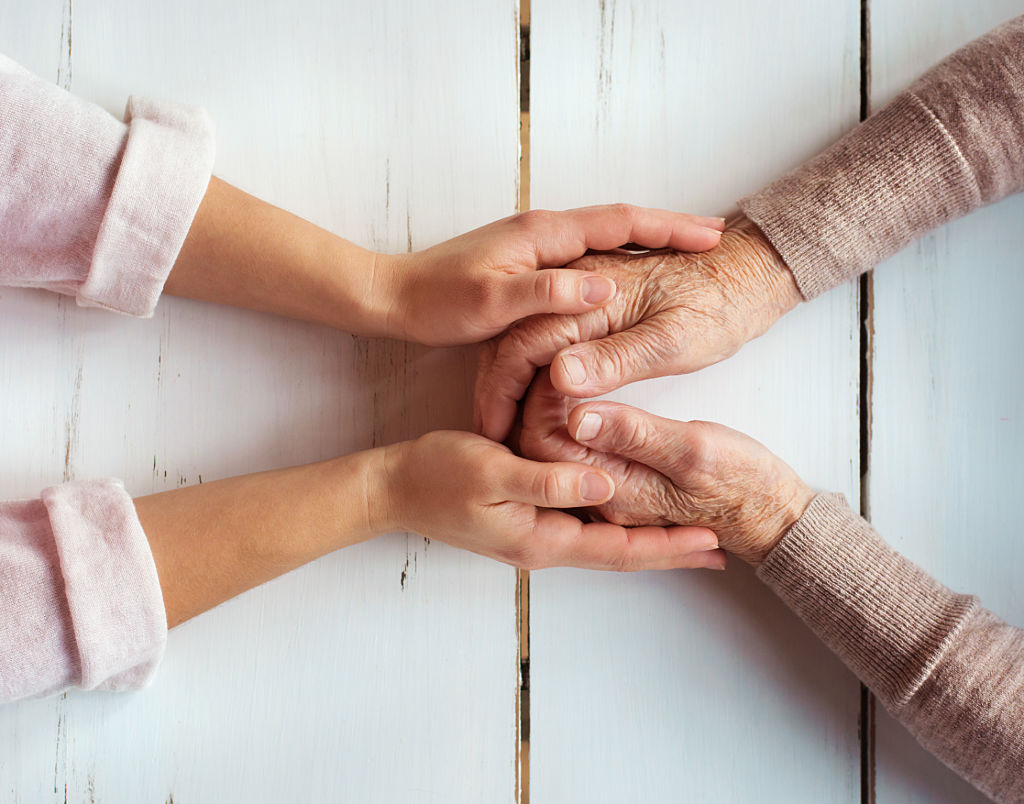Autologous Blood and Marrow Transplantation: Patient Care Resources
Blood and marrow transplant is a treatment option to for people who have certain blood disorders or blood cancers. It also offers a rescue from the effects of the preparative regimen which consists of high-dose chemotherapy.
Autologous transplant, when you're receiving your own stem cells, is utilized more for multiple myeloma, or different types of lymphomas, and occasionally germ cell or testicular cancers.
WHAT TO KNOW FOR AUTOLOGOUS BLOOD AND MARROW TRANSPLANT
Getting Started In Your Care
Getting Your Diagnosis
Planning Your Treatment
Undergoing Treatment & Follow-Up
Autologous Blood and Marrow Transplant: Patient Care Resources
This overview explains what to expect for treatment with blood and marrow transplantation.
Before
During
After
Meet with your blood and marrow transplant specialist
The first appointment with your transplant doctor is an opportunity for you to ask any questions. In your first visit, you will:
- Discuss treatment options and the type of transplant that may be recommended for you.
- Discuss process, potential side effects, outcomes and impact on your day-to-day living, activities and quality of life.
- Bring any paperwork and imaging done outside Stanford for your doctor to review.
- Be offered your next appointment to begin the transplant process, if appropriate.
Your first visit is also an important opportunity to tell the doctor and care team about your past medical history and all of the medicines you take – even occasionally. Some prescriptions, vitamins, supplements, and herbal remedies can affect how your body responds to treatment, so it is important to tell your doctor about all of them.
We can help you get started with a checklist of what to expect and what to prepare.
We use the information we gathered during your initial appointment to carry out your treatment plan.
Preparing for your transplant
To prepare for your transplant, you will undergo several tests to discover the types of stem cells you need. You will receive chemotherapy with or without radiation to fight your disease and to prepare your body to receive the new stem cells.
After receiving a preparative therapy of chemotherapy with or without radiation treatment, your ability to fight infections will be compromised. You will need to wear a special filtered mask when you are outside your hospital room and home. You will also need to follow a special diet to control your risk of infection from the foods you eat.
We will monitor you closely throughout your transplant and recover to address any complications.
If you are are to have an autologous transplant, we will give you injections of a medications called growth factors with or without chemotherapy to stimulate your stem cells to move from the bone marrow into the blood stream. We will collect your stem cells in a process called apheresis. During apheresis your blood is removed and spins through a machine that will separate the stem cells from the other cellular components of your blood like red blood cells, white blood cells, and platelets. After the stem cells are removed the rest of the blood is returned to you. Apheresis takes about 4 hours per day and may be carried out over 1 to 5 consecutive days. After the stem cells are collected, they are taken to the laboratory for freezing.
Before receiving your stem cells, you will receive a preparative therapy of chemotherapy with or without radiation therapy. The dose of chemotherapy can range from very low doses to high doses. The preparative treatment is used to eliminate your cancer cells and create space in the bone marrow for the stem cells. The preparative therapy may be given over 1 to 13 days. You may be treated in the hospital or through an outpatient clinic in the cancer center.
During transplant
One to two days after receiving the preparative therapy, the stem cells will be infused into your body. You should begin making new blood cells 2-3 weeks after the transplant. The recovery of the blood counts is a milestone called engraftment.
The first sign of engraftment is a rising white blood cell count. You will begin to feel “normal” about 3 -6 months after transplant, but full recovery may take a year or longer.
Recovery is influenced by several factors, including the original diagnosis, your age, your overall health, the dose of chemotherapy and radiation you received, and the types of complications you experienced during transplant.
Follow-up appointments
About 100 days after your transplant, your care will be transitioned to your primary BMT physician for check-ups about once every three months. Your doctor will ask you how you are doing, assess your progress, and offer additional care and guidance.
Cancer survivorship and palliative care
Stanford’s cancer survivorship program provides supportive services to help you and your loved ones. Our services address the physical, emotional, psychosocial, spiritual, and financial challenges of cancer and its treatment. We offer classes, health care, and counseling for cancer survivors.
Our cancer survivorship team works with you to develop a plan for transitioning from active treatment to surveillance and ongoing care. We encourage you to contact our survivorship team early in your treatment process.
Our palliative care specialists work closely with yourcare team to maintain your quality of life and achieve your personal goals after cancer treatment. Some of our palliative care services include:
- Managing your symptoms
- Helping you define your treatment goals
- Helping you with advance care planning
- Providing social workers for emotional and spiritual support
Find out more about our palliative care and other supportive services for people with cancer.
Meet with your blood and marrow transplant specialist
The first appointment with your transplant doctor is an opportunity for you to ask any questions. In your first visit, you will:
- Discuss treatment options and the type of transplant that may be recommended for you.
- Discuss process, potential side effects, outcomes and impact on your day-to-day living, activities and quality of life.
- Bring any paperwork and imaging done outside Stanford for your doctor to review.
- Be offered your next appointment to begin the transplant process, if appropriate.
Your first visit is also an important opportunity to tell the doctor and care team about your past medical history and all of the medicines you take – even occasionally. Some prescriptions, vitamins, supplements, and herbal remedies can affect how your body responds to treatment, so it is important to tell your doctor about all of them.
We can help you get started with a checklist of what to expect and what to prepare.
close Before
We use the information we gathered during your initial appointment to carry out your treatment plan.
Preparing for your transplant
To prepare for your transplant, you will undergo several tests to discover the types of stem cells you need. You will receive chemotherapy with or without radiation to fight your disease and to prepare your body to receive the new stem cells.
After receiving a preparative therapy of chemotherapy with or without radiation treatment, your ability to fight infections will be compromised. You will need to wear a special filtered mask when you are outside your hospital room and home. You will also need to follow a special diet to control your risk of infection from the foods you eat.
We will monitor you closely throughout your transplant and recover to address any complications.
If you are are to have an autologous transplant, we will give you injections of a medications called growth factors with or without chemotherapy to stimulate your stem cells to move from the bone marrow into the blood stream. We will collect your stem cells in a process called apheresis. During apheresis your blood is removed and spins through a machine that will separate the stem cells from the other cellular components of your blood like red blood cells, white blood cells, and platelets. After the stem cells are removed the rest of the blood is returned to you. Apheresis takes about 4 hours per day and may be carried out over 1 to 5 consecutive days. After the stem cells are collected, they are taken to the laboratory for freezing.
Before receiving your stem cells, you will receive a preparative therapy of chemotherapy with or without radiation therapy. The dose of chemotherapy can range from very low doses to high doses. The preparative treatment is used to eliminate your cancer cells and create space in the bone marrow for the stem cells. The preparative therapy may be given over 1 to 13 days. You may be treated in the hospital or through an outpatient clinic in the cancer center.
During transplant
One to two days after receiving the preparative therapy, the stem cells will be infused into your body. You should begin making new blood cells 2-3 weeks after the transplant. The recovery of the blood counts is a milestone called engraftment.
The first sign of engraftment is a rising white blood cell count. You will begin to feel “normal” about 3 -6 months after transplant, but full recovery may take a year or longer.
close During
Recovery is influenced by several factors, including the original diagnosis, your age, your overall health, the dose of chemotherapy and radiation you received, and the types of complications you experienced during transplant.
Follow-up appointments
About 100 days after your transplant, your care will be transitioned to your primary BMT physician for check-ups about once every three months. Your doctor will ask you how you are doing, assess your progress, and offer additional care and guidance.
Cancer survivorship and palliative care
Stanford’s cancer survivorship program provides supportive services to help you and your loved ones. Our services address the physical, emotional, psychosocial, spiritual, and financial challenges of cancer and its treatment. We offer classes, health care, and counseling for cancer survivors.
Our cancer survivorship team works with you to develop a plan for transitioning from active treatment to surveillance and ongoing care. We encourage you to contact our survivorship team early in your treatment process.
Our palliative care specialists work closely with yourcare team to maintain your quality of life and achieve your personal goals after cancer treatment. Some of our palliative care services include:
- Managing your symptoms
- Helping you define your treatment goals
- Helping you with advance care planning
- Providing social workers for emotional and spiritual support
Find out more about our palliative care and other supportive services for people with cancer.
close After

Your doctors
Hematologist
This type of doctor has specialized training in disorders of the blood and bone marrow and treating these disorders using drug therapy, as well as blood and marrow transplant.
Medical Oncologist
This type of doctor has specialized training in diagnosing and treating cancer using drugs. Medical oncologists often serve as your main health care provider, coordinating your treatment among several specialists.

Extended care team
This health care provider works with your surgical oncologist to help with diagnosis and treatment. The provider can be a nurse practitioner, physician’s assistant, or clinical nurse specialist.
These coordinators are specialized registered nurses who provide one-on-one support to guide you through the cancer treatment process. The coordinators serve as your point of contact to help manage your care, from your first appointment through follow-up visits. They assess your needs, answer your questions, make referrals, coordinate appointments, and provide patient education.
These assistants help with administrative issues such as scheduling your appointments, managing your paperwork, and requesting your medical records.
If you need to stay in the hospital after surgery, a registered nurse will take care of you.
This team member greets you at the front desk and registers you for your appointments.
If you have apheresis (a specific type of blood transfusion) or chemotherapy, your infusion treatment area (ITA) scheduler will set up your appointments.
This team member helps you during your doctor visits by:
- Bringing you to your exam room after you check in for an appointment
- Providing you with a hospital gown or other clothing for your physical exam
- Taking your vital signs before your doctor sees you
A staff member calls you before your first appointment to:
- Provide information that you need to know to prepare
- Provide a list of what you need to bring
- Help gather your medical records

Support services
PathWell is your connection to personalized support services before, during, and after your treatment. Our teams of doctors, nurses, social workers, spiritual care providers, nutrition experts, financial counselors, and more work with your oncology team to provide comprehensive specialized care to you and to your family.
- 650-498-6000 Ask for the PathWell team
Stanford Health Library
For confidential help with your health care questions, contact the Stanford Health Library. Professional medical librarians and trained volunteers can help you access journals, books, e-books, databases, and videos to learn more about medical conditions, treatment options, and related issues.
- 875 Blake Wilbur, Palo Alto: 1st floor near the cafe, 650-736-1960
- South Bay Cancer Center: 3rd floor lobby, 408-353-0197
Email us your questions: healthlibrary@stanfordhealthcare.org
